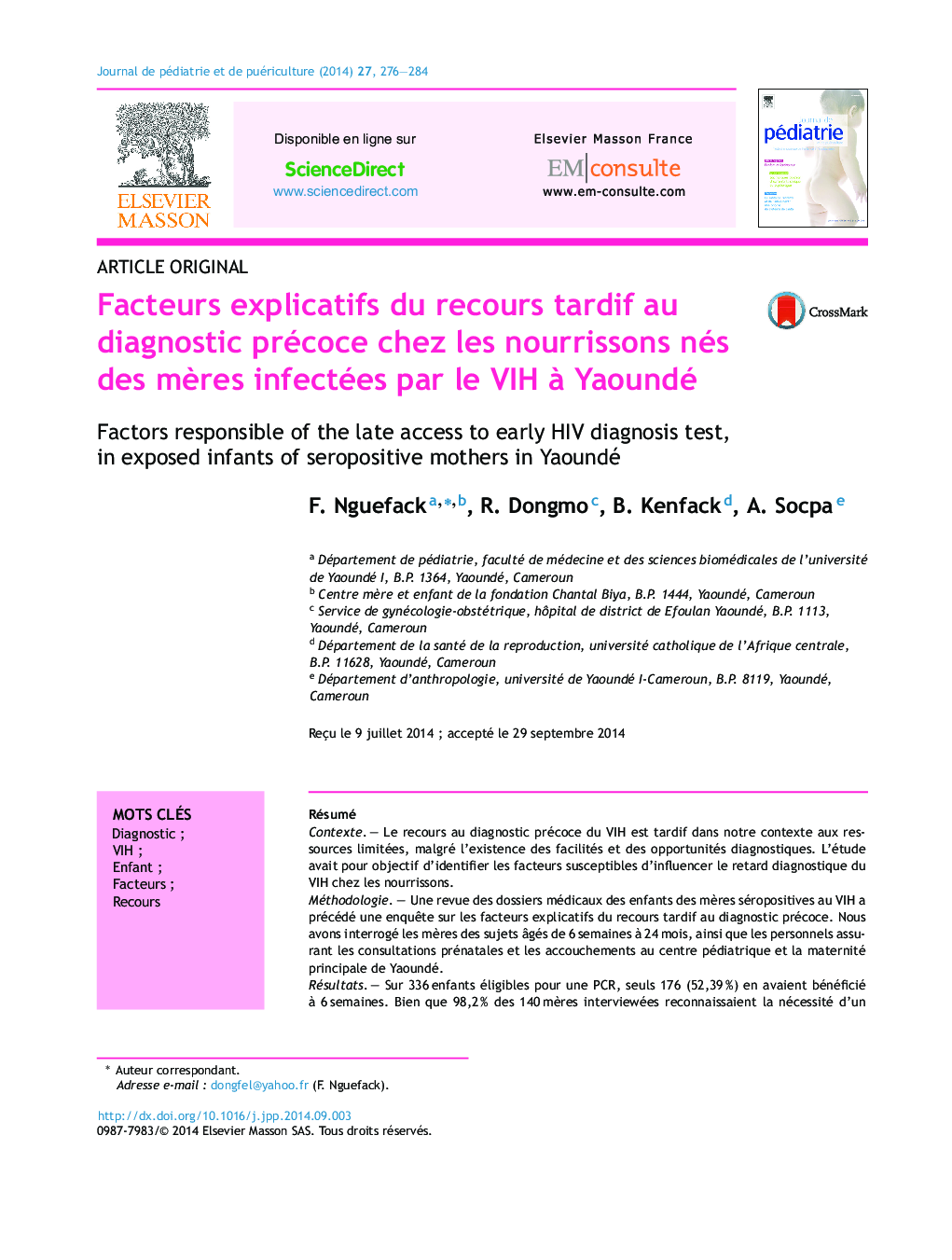| Article ID | Journal | Published Year | Pages | File Type |
|---|---|---|---|---|
| 4169708 | Journal de Pédiatrie et de Puériculture | 2014 | 9 Pages |
RésuméContexteLe recours au diagnostic précoce du VIH est tardif dans notre contexte aux ressources limitées, malgré l’existence des facilités et des opportunités diagnostiques. L’étude avait pour objectif d’identifier les facteurs susceptibles d’influencer le retard diagnostique du VIH chez les nourrissons.MéthodologieUne revue des dossiers médicaux des enfants des mères séropositives au VIH a précédé une enquête sur les facteurs explicatifs du recours tardif au diagnostic précoce. Nous avons interrogé les mères des sujets âgés de 6 semaines à 24 mois, ainsi que les personnels assurant les consultations prénatales et les accouchements au centre pédiatrique et la maternité principale de Yaoundé.RésultatsSur 336 enfants éligibles pour une PCR, seuls 176 (52,39 %) en avaient bénéficié à 6 semaines. Bien que 98,2 % des 140 mères interviewées reconnaissaient la nécessité d’un diagnostic précoce, moins de la moitié (47,9 %) indiquaient le moment approprié pour sa réalisation. En outre, seules deux tiers des mères (67,1 %) étaient informées du test. Certains personnels ne maîtrisaient pas la période précise du diagnostic, bien qu’ils aient tous été formés en PTME. Les principales raisons du retard diagnostique du VIH étaient l’ignorance du statut VIH de la mère, le manque de moyens financiers, le refus et la peur du conjoint.ConclusionLa performance du diagnostic précoce passerait par l’amélioration de l’information des femmes et de leur conjoint sur les piliers de la PTME. Il est nécessaire de renforcer les connaissances et pratiques du personnel assurant les CPN et les accouchements à travers une supervision formative.
SummaryContextEarly diagnosis of HIV is usually carried out late in our resource-limited context in spite of the existence of facilities and diagnostic opportunities. The objective of this study was to identify factors, which could be responsible for late diagnosis of HIV in infants of seropositive mothers.Patients and methodsA review of the medical records of HIV-exposed infants was done, followed by a qualitative inquiry of the factors that could explain the late request for early diagnosis. We carried out an individual semi-structured interview with the mothers of the children aged 6 weeks to 24 months. The survey also involved health personnel in charge of antenatal care and deliveries in a pediatric centre and the Yaoundé Central Maternity respectively.ResultsOut of the 336 children eligible for PCR, only 176 (52%) had benefited from it at 6 weeks. Given though 98.2% of the 140 mothers interviewed were aware of the need for early diagnosis, less than half (47.9%) knew the appropriate time which it should be done. Furthermore, only two-third of the mothers (67.1%) were informed about the test. Amongst those who knew that the diagnosis is done between birth and 6 weeks or between 6 weeks and 3 months, 65.3% did the test on time. Some health personnel did not know the precise period for diagnosis even though they had all been trained on PMTCT. About 50% knew that early diagnosis is carried out at 6 weeks. For others, it is performed either at birth, at 18 weeks or at 3 months (10% respectively), or at 18 months (20%). The main reasons for late diagnosis of HIV was ignorance of HIV status of the mothers, lack of finances, refusal and the fear of being rejected by the partner.ConclusionCarrying out early diagnosis of HIV can be ameliorated by informing mothers and their partners about the PMTCT pillars. It is necessary to reinforce the knowledge and the practices of health personnel in charge of antenatal care and deliveries by doing supervisions training.
